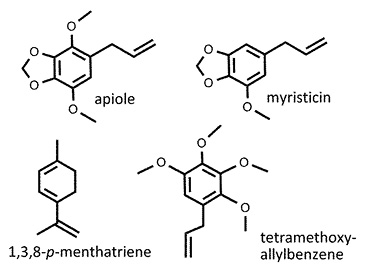 Petroselinum crispum
Petroselinum crispum
parsley
Back to “Salad herbs and herb mixtures: parsley (Petroselinum crispum)”
Back to “Culinary herbs: parsley (Petroselinum crispum)*”
Petroselinum crispum (Mill.) A.W. Hill (Apiaceae); pieters(i)elie (Afrikaans); fan yan sui (Chinese); persil (French); Petersilie (German); prezzemolo (Italian); perejil (Spanish)
DESCRIPTION Parsley leaves are typically bright green, hairless, with curly edges in the common type and flat leaflets in the flat-leaved type. They have a fragrant, fresh and slightly spicy aroma and tangy, sweet, slightly grassy taste.1 Flat-leaved parsley (var. neapolitanum), also called Italian, French, or celery-leaved parsley, has a slightly stronger aroma and is often recommended for culinary use, while the crisped type is the best choice for garnishing. Hamburg or turnip-rooted parsley (var. tuberosum)2 is a root vegetable resembling parsnip.
THE PLANT A biennial herb forming a rosette of leaves in the first year and a stem with small yellow flowers and small dry fruits in the second year.
ORIGIN Mediterranean parts of southern Europe and western Asia.2 Parsley features in Greek and Roman mythology and early medicinal texts. It is of major commercial importance today and in most countries the supplies are grown domestically.1
CULTIVATION Sow seeds in spring and again in summer to ensure a year-round supply. Germination is very slow (up to three weeks or more). Use small pots or plug trays or sow directly, as parsley does not like being transplanted. Plants are spaced 15 cm (6 in.) apart and grow best in rich loam soil with a neutral pH that is kept moist. Regular feeding with liquid fertilizer is recommended.
HARVESTING Fresh leaves can be picked throughout the first growing season. Freezing is the best way to preserve parsley. On a commercial scale, drying or freeze-drying is used, and oil is distilled from both the leaves and the fruits.
CULINARY USES Parsley is the best known and most widely used of all culinary herbs and garnishes. It is the main ingredient of French fines herbes, together with chervil, tarragon and chives.3 Fresh leaves are a popular ingredient of soups, salads, sauces, omelettes, stews and stuffings for meat. Chopped parsley is sprinkled over food and often added to cooked dishes just before serving. It is commonly used to flavour butter, cheese and sauces. The term persillade is used in French cooking for a mixture of chopped parsley and garlic that is added to certain dishes at the end of the cooking time (e.g. beef persillade).3 The word persillé is used for veined cheeses but also for dishes that are finished with persillade or with large amounts of chopped parsley (e.g. ham with parsley or jambon persillé).3 Parsley leaf and fruit oils are commonly used as flavourants in the food industry.1,4
FLAVOUR COMPOUNDS The main flavour compound in parsely leaves has been identified as 1,3,8-p-menthatriene.4 Apiole, myristicin and tetramethoxyallylbenzene are also present but in higher concentrations in the fruit oil.4 Myristicin is the stimulant and hallucinogen principle present in nutmeg. This compound and apiole are toxic at high doses.

NOTES Parsley is a good source of vitamin C (190 mg per 100 g).4
1. Farrel, K.T. 1999. Spices, condiments and seasonings. Aspen Publishers, Gaithersburg, USA.
2. Mabberley, D.J. 2008. Mabberley’s plant-book (3rd ed.). Cambridge University Press, Cambridge.
3. Larousse. 1999. The concise Larousse gastronomique. Hamlyn, London.
4. Harborne, J.B., Baxter, H. 2001. Chemical dictionary of economic plants. Wiley, New York.